|
||||||||||
|
|
||||||||||
|
||||||||||
|
|
||||||||||
I know that Russia built its own Space Shuttle. Why doesn't NASA use it to replace the Columbia?
- question from Charles Monroe
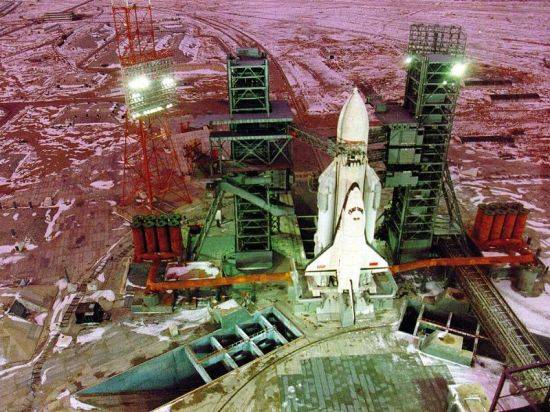
The design requirements specified for the MKS called for a vehicle to accomplish the following goals:
These considerations led to a number of key decisions in the MKS design. For example, the lack of reusable rocket engines meant there was no need to carry the main engines aboard the Buran orbiter itself. The booster system was instead composed of a large central core called the Energia rocket that took the place occupied by the external fuel tank on the US Shuttle. This central core was surrounded by four liquid rocket strap-on boosters similar to the two solid rocket boosters used in the American design. Unlike the US Shuttle, this basic core and strap-on system could also be used as an independent rocket in its own right. The Energia core was a modular design that could be equipped with one to four rocket engines and anywhere from two to eight strap-on boosters. The Energia could also be fitted with different payload capsules permitting considerable flexibility in the launch configuration. The Buran orbiter, in fact, was just one of several payload options that could be attached to the Energia core.

The orbiter itself was an external copy of the American Shuttle but with a number of differences in design details. Although Soviet engineers considered a number of exotic and innovative lifting body configurations for the reusable spacecraft, none appeared to be superior to the shape chosen by the Americans for their orbiter. The Soviets did add a few changes of their own, however. Most notably, removing the propulsion system from the orbiter allowed the vehicle to carry a larger payload of 30 tons into orbit compared to the 25-ton maximum of the US Shuttle. The landing weight was similarly increased to 20 tons from the 15-ton limit for the American orbiter. The Soviets also made provisions to add a pair of jet engines to the aft end of their orbiter so that the final stage of landing could be performed under power. By contrast, the US orbiter is unpowered and must glide to its landing. The engines would have given the Buran an additional safety factor to overcome adverse winds or waveoff and make a new approach to the runway. However, the idea was never implemented on Buran since it was ultimately deemed unnecessarily complicated.
Otherwise, the general layout of the Buran was similar to that of the US orbiter and consisted of a long, cylindrically shaped fuselage attached to a low-mounted double delta wing. A two-deck crew cabin at the forward end of the fuselage contained the flight controls on the upper deck and living space below. Compared to the American orbiter, maximum crew size was increased from seven to ten with room for four cosmonauts provided on the main deck and the remaining six crew on the lower deck. Aft of the cabin was a large payload bay capable of carrying docking modules, a manipulator arm, and payload containers similar to those of the American Shuttle. Also like the US orbiter, the external surface of the Buran was covered with tens of thousands of thermal protection tiles and carbon-carbon material to survive the heat of re-entry. However, the Soviets believed that the orientation selected for the tiles was a more optimum configuration that that used by the US.
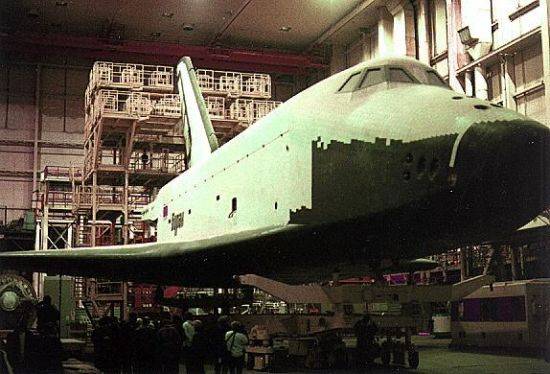
As the overall configuration of the Buran was finalized, the Soviets constructed a number of test articles to validate different aspects of the design. Among the validation tasks were thrust stand measurements of the Energia rocket engines and wind tunnel plus gas dynamic tests of the Buran orbiter from subsonic landing to hypersonic re-entry speeds. The test vehicles included a series of sub-scale models of the Buran launched on sub-orbital flights to collect data on flight handling characteristics and control effectiveness at speeds up to Mach 17.5.
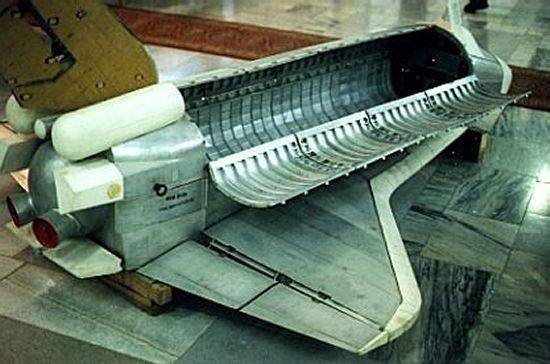
The program also included five full-scale mock-ups and three structural component test articles used to investigate a variety of manufacturing, assembly, and flying quality characteristics as well as handling procedures. Each of these test articles is described in greater detail below.
| Number | Designation | Name(s) | Purpose | Status |
|---|---|---|---|---|
| 0.01 | OK-1M |
OK-M BTS-01 OK-ML-1 |
Full-scale test article used for part fit tests, static loads tests, and Energia interface tests. | Stored outdoors in the Buran safing area at the Baikonur Cosmodrome in Kazakhstan (picture) for many years under deteriorating conditions. Moved to a museum at Baikonur in 2007 (picture) where the craft has been restored for public display (picture). |
| 0.02 | OK-2M |
OK-GLI BTS-02 |
Full-scale aerodynamic flight test vehicle that completed 25 manned test flights. | Displayed during the 2000 Sydney Olympics. Also displayed in Bahrain in 2002 where it remained stored in several pieces for five years. Finally purchased by the Technik Museum in Speyer, Germany, and put on display in 2008 (picture). |
| 0.03 | OK-3M | OK-KS | Full-scale test article for static electronic and electric tests, integration tests, and electromagnetic interference testing. | Stored at the Energia factory in Korolev near Moscow (picture). |
| 0.04 | OK-4M |
OK-MT OK-ML-2 |
Full-scale engineering mock-up used to develop technical and operations manuals, develop fluid loading methods, test crew entry and exits, and interface with the launch vehicle. | Stored in the MIK Building at the Baikonur Cosmodrome in Kazakhstan (picture). |
| 0.05 | OK-5M | OK-? | Forward fuselage structural components used for static vibration and thermal tests. | unknown |
| 0.06 | OK-6M | OK-TVI | Center fuselage payload bay used for vacuum and thermal tests in an environmental chamber. | Stored at the NIIKhIMMash test facility in Moscow (picture). |
| 0.15 | OK-7M | OK-TVA | Full-scale static and dynamic test article used for flight load and stress tests, thermal and vibration tests, environmental chamber testing, and electrodynamic and electrohydraulic tests. | On display as an amusement park ride at Gorkiy Park in Moscow. The craft's condition had deteriorated by 2008 when the exterior, covered in fake wooden thermal files, was removed due to its decay in the elements (picture). The tile pattern has been painted directly onto the bare metal (picture) and the ride remains in operation. |
| 0.08 | OK-8M | OK-? | Structural components used for static thermal and vacuum tests. | unknown |
Perhaps the most interesting of these assets was the OK-GLI aerodynamic flight test vehicle, also known as the "Analog Buran" or "Buran analogue." Though the vehicle could fly, it was limited to low-speed flight within the atmosphere and was not a spaceworthy craft. The Analog Buran was instead equipped with four jet engines allowing it to takeoff from conventional runways. After climbing to altitude, the engines were shut down so the vehicle could glide back to make an unpowered landing. These repetitive landing and taxi tests collected data needed for the development of an autopilot and automated landing system for the actual Buran orbiters. A total of 25 flights were conducted before the Analog Buran was retired.
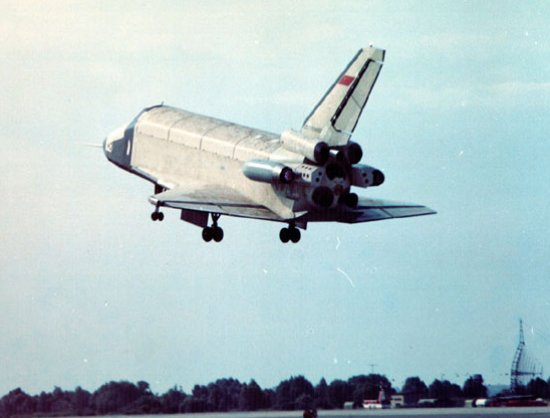
The Analog Buran was later sold to an Australian company that placed the vehicle on display at the 2000 Olympics in Sydney. Though the owner planned to take the vehicle on a tour of several Australian and Asian cities, poor ticket sales in Sydney doomed the venture and the company went bankrupt. An attempt to auction the Analog Buran for $6 million was unsuccessful, and the craft remained stored outdoors for at least a year before a new company purchased the vehicle. OK-GLI was moved to Bahrain where it was displayed during the 2002 Summer Festival. This owner also went bankrupt and was forced to abandon the Analog Buran in a Bahraini junkyard pending the outcome of legal battles with NPO Molniya, the Russian company that had built the craft. There the vehicle remained for another five years until purchased by the Technik Museum and put on exhibit in Germany.
The various other mock-ups served a variety of purposes including static loads and vibration testing, environmental heating and vacuum testing, part fitment tests, developing methods for interfacing the orbiter with the Energia, and maintenance and transport procedures. One of these full-scale test articles later ended up in Moscow's Gorkiy Park where some have described it as "playground equipment." This mock-up was formerly the OK-TVA static and dynamic test article that developers had planned to convert into a space-themed restaurant serving the same kinds of food that cosmonauts eat in space. After this idea fell through, OK-TVA instead became an amusement park "space ride" attraction where visitors are treated to a simulated trip into space. The payload bay provides 30 seats moved by motors to simulate the g-loads during launch and landing as well as weightlessness in orbit. During the ride, movies from Buran's flight are projected on screens in front of and along the sides of the compartment. Customers can also tour the flight deck in the nose that has been equipped with a cockpit mock-up similar to that on a manned orbiter. The attraction's popularity has apparently been declining, however, and a sharp drop in ticket sales forced management to cut the ride's duration in half to 20 minutes by 2000.
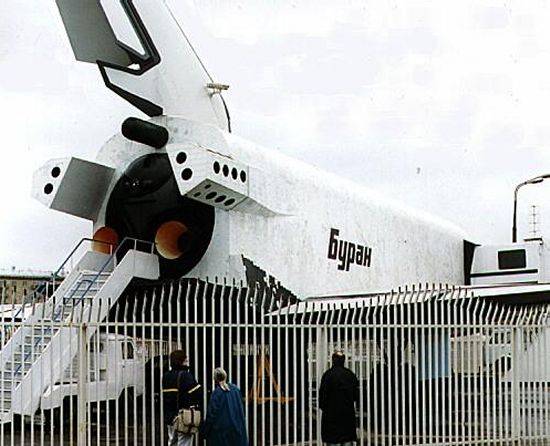
The information gained using these test articles culminated in the first successful flights of the Energia and Buran in the late 1980s. The Energia flew its first operational mission on 11 May 1987, and the launch vehicle performed flawlessly. This success spurred the Soviet's to attempt the first flight of the complete Buran-Energia system the following year. The launch occurred at 0600 on the morning of 15 November 1988 from the Baikonur Cosmodrome in what is now Kazakhstan. Unlike American Shuttle missions, this flight was conducted without a single human aboard the vehicle. The first mission was launched unmanned since the life support system was still not certified or fully installed and software for cockpit displays was incomplete. Moreover, the primary goal of the flight was to test the automated launch, orbital maneuvering, and landing systems developed for the orbiter. It was considered unnecessary to risk a human crew on a shakedown flight.
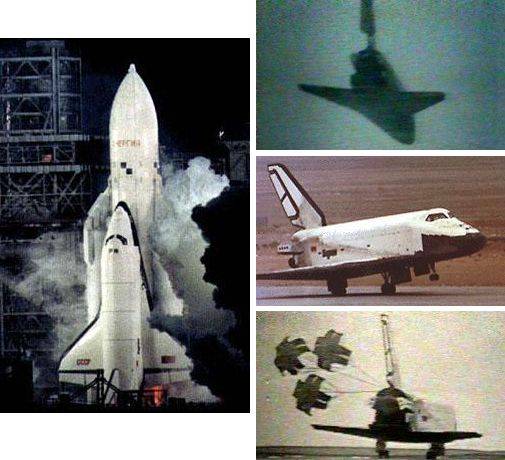
Though the first flight occurred more than four years behind schedule, the mission was a complete success. The automated launch sequence performed flawlessly, and the Energia booster lifted the vehicle into a temporary orbit before the Buran separated as designed. After boosting itself to a higher orbit and completing two circuits around the Earth, the Buran automatically fired its retrorockets to begin the descent back into the atmosphere. Exactly 206 minutes into the mission, the Buran orbiter successfully landed at Baikonur, having lost only five of its 38,000 thermal tiles over the course of the flight. The unmanned flight marked the first time in history that a spacecraft of such size and complexity had been launched, completed maneuvers in orbit, re-entered the atmosphere, and made a precision landing under completely automatic control. As an encore to its successful flight, Buran made a triumphant appearance at the 1989 Paris Air Show while mounted atop its An-225 Mriya transport.
In addition to the Buran, the Soviet program had originally planned to build four additional spaceworthy orbiters. Work had begun on all four but none were completed before the fall of the Soviet Union. Additional information on these orbiters is provided below.
| Number | Designation | Name | Description | Status |
|---|---|---|---|---|
| 1.01 | OK-1K1 | Buran | First orbiter to complete an unmanned space flight, life support systems never fully installed. | Destroyed during the collapse of the Site 112 roof at the Baikonur Cosmodrome in Kazakhstan in 2002. The orbiter's remains were still buried under the rubble of Site 112 at least as of early 2008. |
| 1.02 | OK-2K1 | Ptichka? | Construction was at least 95% complete with only a few electronic systems remaining to be installed. An unmanned flight had originally been planned for 1991 but a complete life support system may have been installed by 1993. | Stored in the MIK Building at the Baikonur Cosmodrome in Kazakhstan (picture). |
| 2.01 | OK-1K2 | unnamed | First orbiter to be equipped for manned flight but only about 40% complete when work stopped. The first manned flight was planned for 1995. | Remained in the Tushino factory in Moscow where it was being assembled until 2004 when it was moved outdoors reportedly so it could be transferred to NPO Molniya or sold to the Technik Museum in Germany (picture). The craft remained in a Tushino parking lot at least five years later (picture). |
| 2.02 | OK-2K2 | unnamed | Second manned orbiter under construction but only about 20% complete when work stopped. | Moved outdoors of the Tushino factory where it was being assembled. Stripped components like thermal tiles have been sold over the internet (picture). |
| 2.03 | OK-3K2 | unnamed | Third manned orbiter under construction but never completed. | Incomplete hulk was dismantled at the factory and no longer exists. |
The first two vehicles were due to complete another three unmanned flights from 1991 to 1993 of increasing length and complexity. These flights would have thoroughly tested the payload bay doors, manipulator arm, ability to dock with the Mir space station, and the ability to remain in orbit for up to three weeks. Although only the first orbiter was named Buran, the second never received an official name of its own. Some sources indicate that this vehicle was known by the unofficial nickname Ptichka for "little bird" while others say this nickname applied to all the orbiters. The next three vehicles represented a second-generation shuttle rated for manned flight through the addition of an improved flight deck, life support systems, and ejection seats. These three were never named though unconfirmed rumors suggest the third might have been called Baikal for "typhoon."
Unfortunately, the ambitious plans to further develop the Buran and her sisters for a variety of military and scientific applications were not to be. Funding for the program was slashed almost immediately after the first flight and further work had essentially stopped even before the collapse of the Soviet Union. The Buran never flew again, and though never officially cancelled, President Boris Yeltsin finally cut off the last trickle of funding in 1993. Shortly thereafter, head of NPO Energia Yuri Semenov confirmed the stoppage when he publicly admitted the project was dead. The ultimate failure of the Buran program was due to its massive cost estimated between 14.5 and 20 billion Rubles. This burden was so enormous and put such a strain on the national economy that it was likely a contributing factor to the demise of the Soviet Union itself. The Buran, Ptichka, and test vehicles at Baikonur are now the sole property of Kazakhstan having been bartered to the independent republic in exchange for Russia's continued use of Baikonur's launch facilities.
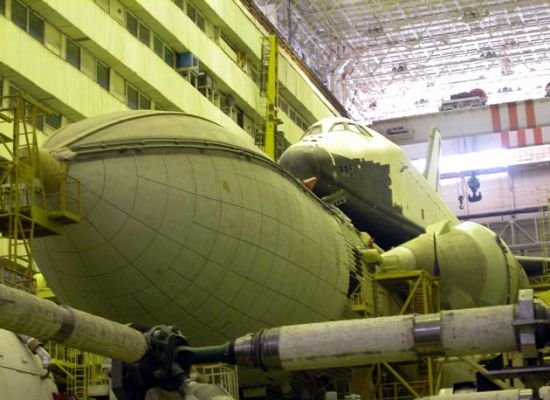
Nevertheless, the question remains as to whether the project could be resurrected to supplement the US Shuttle fleet, especially given the loss of the Columbia in February 2003. The Russians themselves had implied that the program might be renewed as recently as 2001. Many of its components had been placed in storage, including the Buran orbiter that was mounted atop a nearly completed Energia booster and placed in a building called Site 112 at Baikonur.
Unfortunately, the prospects for reviving the shuttle project now appear more unlikely than ever. On 12 May 2002, most of the roof of the enormous Site 112 where the Buran orbiter and all remaining Energia boosters were being stored collapsed. Funding had been cut so low that routine maintenance had not been performed on the building in over a decade. The roof was known to leak and sag excessively under the weight of snow. This lack of maintenance coupled with strong winds finally led to a structural collapse that killed eight workers and destroyed the Buran.
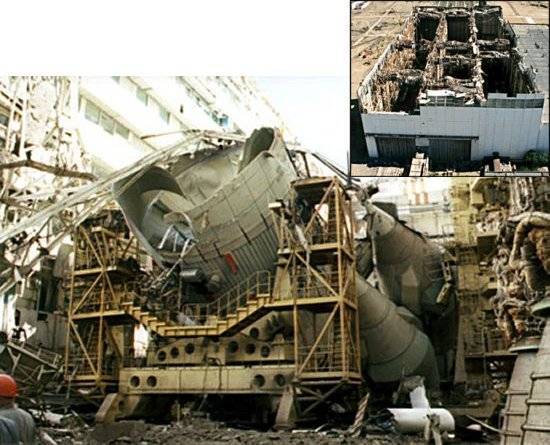
In addition to the Buran, the second orbiter Ptichka was nearly completed when the program was stopped in 1993. The craft was also placed into storage at Baikonur and is believed to remain in relatively good condition. The third orbiter was only about 40% complete when work stopped and remained stored at the factory until it was moved outdoors and left to the elements in 2004. Assembly of the fourth orbiter had progressed to about 20% completion before the incomplete hulk was moved out of the factory. Thermal tiles and other parts stripped from the craft have even been offered for sale on the internet. Work had also started on the fifth orbiter, but it was dismantled at the production site in 1995. The former orbiter manufacturing plant was reportedly converted to produce buses, syringes, and diapers.
The loss of the only flight-worthy vehicle and the poor state of the infrastructure originally put in place to
manufacture, launch, maintain, and support the Russian shuttle has almost surely sounded the death-knell of the
Buran project once and for all.
- answer by Jeff Scott, 7 December 2003 (revised October 2010)
Update!
New photos of the wreckage at Site 112 have become available showing the extent of the damage to the Buran orbiter. While the remains of the launcher are obvious in this first photo, Buran is difficult to make out. The most identifiable pieces are the forward fuselage containing the crew cabin that can be seen in the center of the photo and one of the aft thruster pods visible on the right.
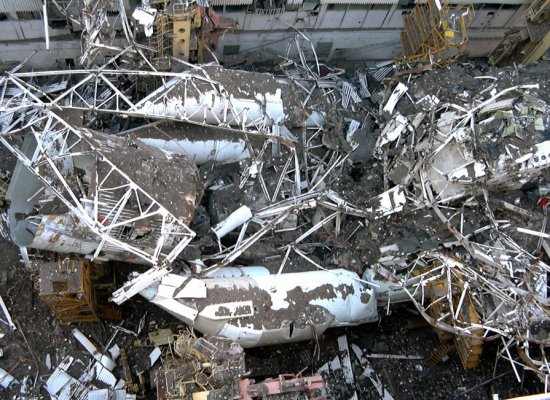
The damage is perhaps even more apparent in the following closeup of the crew cabin. The flight deck windows have been knocked out by the collapsed roof and the remainder of the orbiter is extensively battered. The heat tiles are also clearly visible confirming that this vehicle is one of the spaceworthy orbiters and not a mockup or test article.
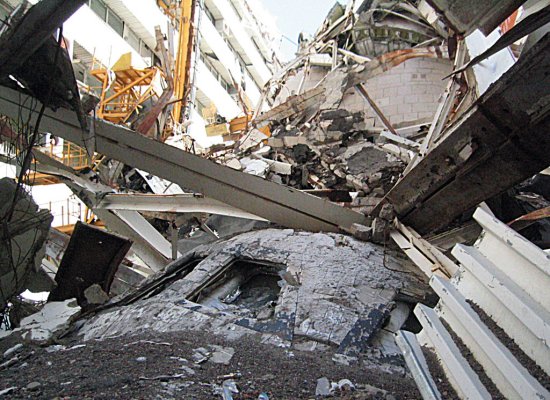
The Site 112 photos suggest that Buran and the Energia booster were essentially broken in half after the building's
roof fell on the middle of the shuttle stack. The damage is extensive and the Buran is a total loss. The Buran
wreckage apparently still remains in Site 112 as no attempt has been made to clear the debris from the roof
collapse.
- answer by Jeff Scott, 5 February 2007
Related Topics:
What was the worst disaster in the history of space travel?
What has become of the HOTOL re-usable rocket concept?
Read More Articles:


|
Aircraft | Design | Ask Us | Shop | Search |

|
|
| About Us | Contact Us | Copyright © 1997-2023 | |||
|
|
|||